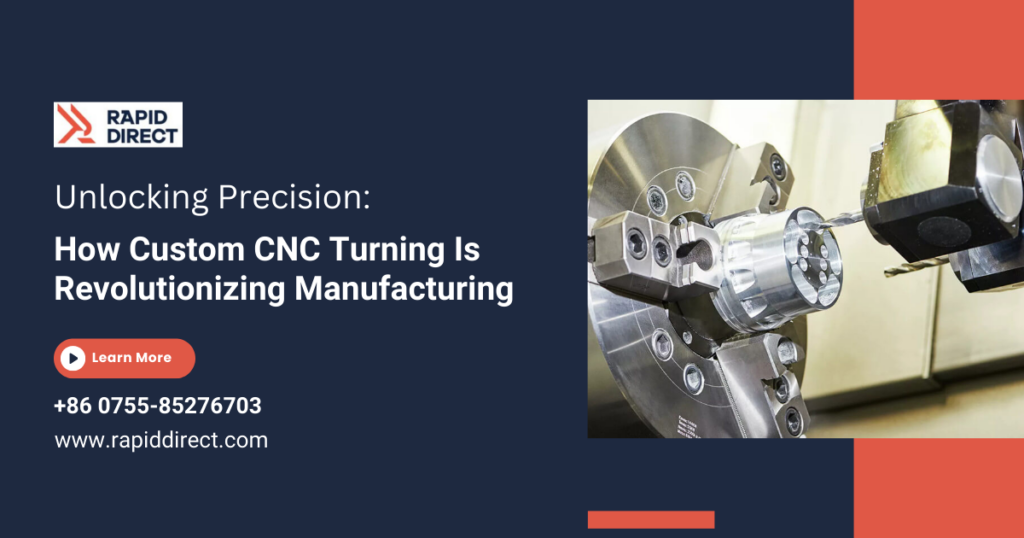In today’s rapidly evolving manufacturing landscape, precision and efficiency are not just buzzwords—they’re essential elements that can make or break a business. As industries worldwide strive to meet increasing demands for quality and speed, one technology stands out for its ability to deliver: custom CNC turning. This innovative machining process allows manufacturers to create highly accurate and intricate components with remarkable consistency, transforming traditional manufacturing methods in the process.
At the heart of this revolution is CNC (Computer Numerical Control) technology, which automates the machining process by using computer software to control machine tools. With custom CNC turning, manufacturers can design parts that meet exact specifications, offering unprecedented levels of customization that were previously unattainable with traditional machining techniques. This capability not only enhances product quality but also significantly reduces lead times, enabling companies to respond swiftly to market changes and customer needs.

Shenzhen Rapid Direct Co., Ltd. is at the forefront of this transformation, leveraging advanced custom CNC turning technologies to deliver exceptional solutions to clients across various industries. By integrating precision engineering with cutting-edge technology, the company is helping businesses optimize their manufacturing processes and achieve their goals more efficiently than ever.
What Is Custom CNC Turning?
Definition and Explanation of CNC Turning
Custom CNC turning is a sophisticated manufacturing process that involves rotating a workpiece on a lathe while a cutting tool shapes it into the desired form. Unlike traditional machining methods, where operators manually control the tools, CNC turning is automated. This automation allows for high levels of precision and repeatability, making it ideal for producing complex parts that require exact specifications.
In the CNC turning process, computer software dictates the movements of the machine tool based on a digital design. The operator inputs the design into the system, and the CNC lathe executes the instructions remarkably accurately. This automation streamlines production and minimizes human error, ensuring that every part meets the specified tolerances.
Comparison with Traditional Machining Methods
While traditional machining methods often rely on manual control and adjustment, custom CNC turning represents a significant advancement. In conventional machining, operators must physically handle tools and make real-time decisions based on their observations. This approach can lead to inconsistencies and variability in the finished product.
In contrast, custom CNC turning eliminates many of these variables. Once the design is programmed into the CNC machine, it can produce identical parts with the same level of precision, regardless of the time of day or the operator’s skill level. This consistency is crucial in industries where quality control is paramount, such as aerospace, automotive, and medical manufacturing.
The Evolution of CNC Technology
Historical Context of CNC Technology
The journey of CNC technology began in the mid-20th century. The first numerically controlled machines were developed during the 1940s and 1950s, primarily for the aerospace and defense sectors. These machines were revolutionary, allowing for greater accuracy and efficiency. However, it wasn’t until the advent of computer technology that CNC machines truly began to flourish.
The introduction of personal computers in the 1980s paved the way for more sophisticated CNC software, enabling more intricate designs and automated processes. As the technology evolved, manufacturers began to adopt CNC machines not just for large-scale production, but also for custom, low-volume manufacturing.
Key Advancements in CNC Turning
Over the years, CNC turning technology has seen numerous advancements. Some of the most notable include:
- Increased Automation: Modern CNC lathes are equipped with advanced features such as automatic tool changers, allowing for uninterrupted production runs and greater efficiency.
- Enhanced Software Capabilities: CAD (Computer-Aided Design) and CAM (Computer-Aided Manufacturing) software have evolved to support more complex geometries and streamline the design process.
- Improved Materials: The development of high-performance materials has expanded the applications of CNC turning, allowing for the production of parts that can withstand extreme conditions.
- Integration with IoT: The Internet of Things (IoT) has introduced smart manufacturing capabilities, enabling machines to communicate and optimize their performance in real-time.
Advantages of Custom CNC Turning
Precision and Accuracy
One of the primary advantages of custom CNC turning is the unparalleled precision it offers. CNC machines can achieve tolerances as tight as ±0.001 inches, making them suitable for applications that require extreme accuracy. This level of precision is crucial in industries like aerospace, where even the slightest deviation can have serious consequences.
Flexibility and Customization
Custom CNC turning allows manufacturers to create parts tailored to specific requirements. This flexibility is especially valuable in industries that require unique components or limited production runs. With traditional machining methods, creating a new tool or setup for a one-off part can be costly and time-consuming. CNC turning, on the other hand, enables quick adjustments to designs without the need for extensive retooling.
Efficiency and Reduced Lead Times
Another significant benefit of custom CNC turning is its efficiency. The automated nature of CNC machines allows for faster production times compared to manual machining. Once the design is set, CNC machines can operate continuously, producing parts at a high rate without sacrificing quality. This efficiency translates to shorter lead times, enabling companies to respond rapidly to customer demands.
Applications of Custom CNC Turning
Industries Benefiting from CNC Turning
Custom CNC turning finds applications across various industries, each leveraging its advantages for specific needs:
- Automotive: Manufacturers use CNC turning to create components like engine parts, transmission housings, and brake systems with high precision and durability.
- Aerospace: The aerospace industry relies on CNC turning for critical components such as turbine blades, landing gear, and structural parts that must meet strict safety standards.
- Medical: Custom CNC turning is used to produce intricate surgical instruments, implants, and diagnostic equipment, where precision is essential for patient safety and performance.
Examples of Specific Applications in Each Industry
- Automotive: Companies like Ford and BMW utilize custom CNC turning to manufacture high-performance engine blocks that require tight tolerances for optimal performance.
- Aerospace: Boeing employs CNC turning for parts that must withstand extreme temperatures and pressures, ensuring the safety and reliability of their aircraft.
- Medical: Surgical device manufacturers rely on CNC turning to produce components like screws and housings, where precision is critical for functionality and safety.
How Custom CNC Turning Works
Step-by-Step Overview of the CNC Turning Process
The custom CNC turning process involves several key steps:
Design creation: CAD software is used to create digital designs.
- Programming the CNC Machine: The design is then converted into a format that the CNC machine can understand using CAM software. This programming includes defining tool paths, speeds, and feeds.
- Material Preparation: The chosen material is loaded onto the CNC lathe. Metals, plastics, and composites are the most common materials.
- Machining: The cutting tool shapes the workpiece according to the programmed instructions while the CNC machine starts the turning process by rotating the workpiece.
- Quality Inspection: Once the part is produced, it undergoes rigorous quality control checks to ensure it meets the specified tolerances and standards.
Importance of CAD/CAM Software in Design
CAD/CAM software plays a crucial role in the custom CNC turning process. CAD allows engineers and designers to create intricate designs, while CAM converts these designs into machine-readable instructions. This integration streamlines the workflow, reduces errors, and enhances the overall efficiency of the manufacturing process.
Quality Control in Custom CNC Turning
Methods of Ensuring Quality and Precision
Ensuring the quality and precision of parts produced through custom CNC turning is vital. Manufacturers employ several methods to achieve this:
- In-Process Inspection: Many CNC machines are equipped with sensors that monitor critical parameters during production. This real-time feedback allows operators to make immediate adjustments if deviations occur.
- Final Inspection: After production, parts are typically inspected using various techniques, such as coordinate measuring machines (CMM), to verify that they meet the required specifications.
Role of Inspection and Testing
Inspection and testing are essential components of the custom CNC turning process. By thoroughly checking each part, manufacturers can identify potential issues before they reach the customer. This proactive approach not only ensures quality but also helps maintain the manufacturer’s reputation for excellence.
Material Options for CNC Turning
Common Materials Used
Custom CNC turning can accommodate a wide range of materials, each with its unique properties. Some of the most commonly used materials include:
- Metals: Aluminum, stainless steel, and titanium are frequently used in CNC turning due to their strength and machinability.
- Plastics: Materials like ABS and polycarbonate offer excellent flexibility and are often used in consumer products and medical devices.
- Composites: Advanced composite materials can be machined to create lightweight yet strong components, ideal for aerospace applications.
Impact of Material Selection on Final Product Quality
The choice of material significantly influences the final product’s quality and performance. For instance, selecting a high-strength alloy for automotive components can enhance durability and reliability, while using lightweight plastic in medical devices can improve usability and patient comfort. Understanding the properties of each material helps manufacturers make informed decisions that align with their production goals.

Future Trends in Custom CNC Turning
Emerging Technologies
As technology continues to advance, the future of custom CNC turning looks promising. Some emerging trends include:
- Automation and Robotics: The integration of robotic systems with CNC machines is enhancing automation capabilities, allowing for more complex and efficient production processes.
- 3D Printing Integration: Combining CNC turning with 3D printing technologies can offer new possibilities for creating complex geometries and optimizing production workflows.
- Sustainable Practices: The focus on sustainability is driving manufacturers to explore eco-friendly materials and waste-reduction techniques, making custom CNC turning a more environmentally conscious option.
Potential Developments in the Industry
The CNC turning industry is poised for continued growth and innovation. As manufacturers seek to enhance efficiency and reduce costs, we can expect to see advancements in software capabilities, machine performance, and material technology. These developments will further solidify custom CNC turning’s role as a cornerstone of modern manufacturing.
Custom CNC turning is revolutionizing the manufacturing landscape, offering unprecedented levels of precision, efficiency, and flexibility. As industries strive to meet the demands of an increasingly competitive marketplace, the adoption of custom CNC turning technology is becoming essential. With its ability to produce high-quality components tailored to specific needs, this innovative process is reshaping how manufacturers approach production.
Shenzhen Rapid Direct Co., Ltd. stands at the forefront of this transformation, providing cutting-edge solutions that empower businesses to achieve their goals. By leveraging the advantages of custom CNC turning, manufacturers can enhance their operations, reduce lead times, and ultimately deliver superior products to their customers.